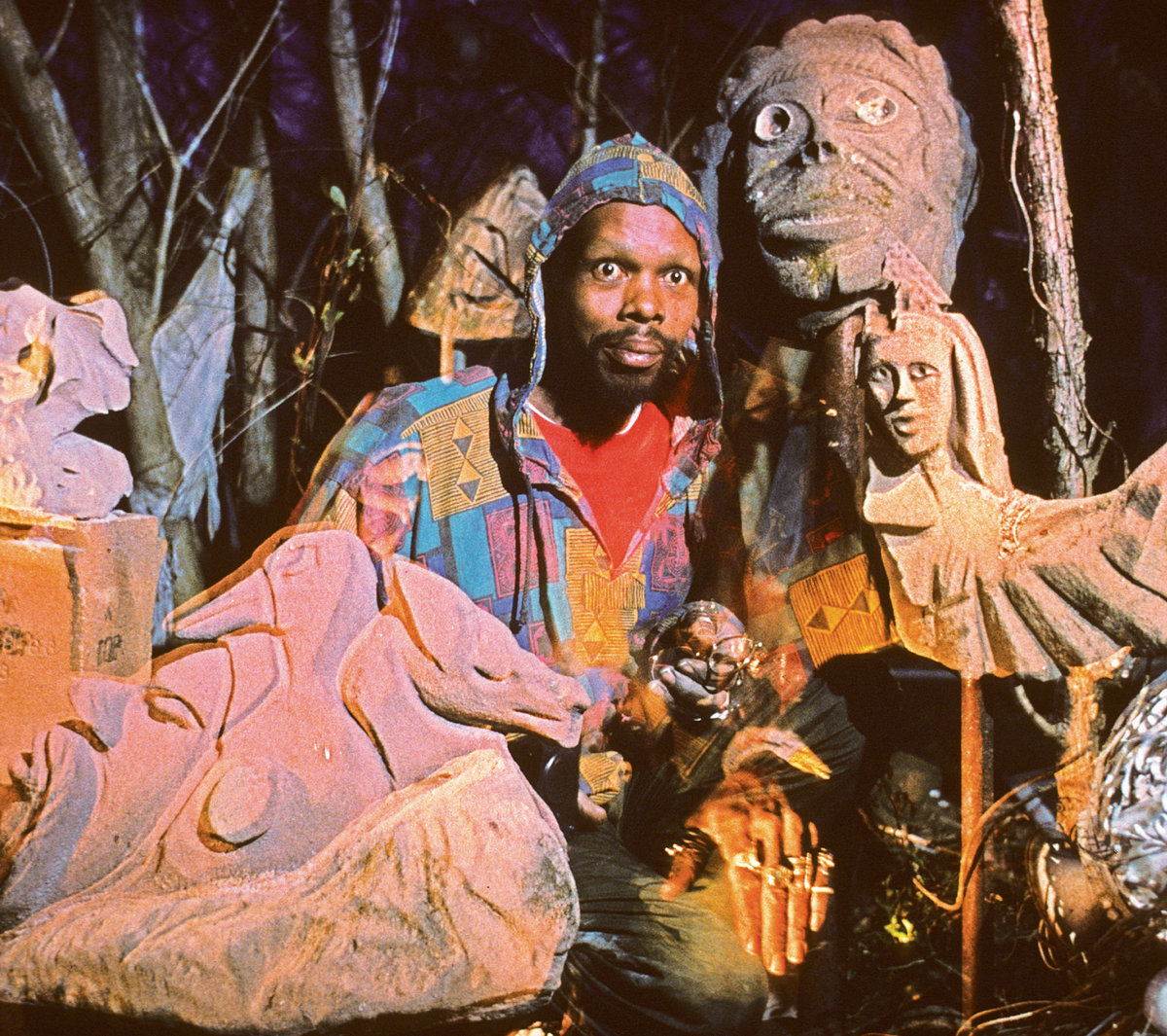Die großformatigen Installationen des iranischen Künstlerkollektivs in der Schirn versetzen die Betrachter*innen in eine Welt voller Bezüge und Anmerkungen. Mit melancholischer Poesie und bissigem Humor reflektieren die Künstler die Abstrusität der globalen Welt. Dies spiegelt sich auch in dem Soundtrack wider, den Haerizadeh, Haerizadeh und Rahmanian für das Schirn Magazin erstellt haben. Die Playlist führt ein Ritual des Musikhörens ein, ähnlich den Ritualen ihrer Kunstproduktion. Den Aufbau ihres Soundtracks vergleichen die Künstler mit der biologischen Vervielfältigung einer DNA-Struktur, für ein tieferes Verständnis von ihrem Ritual des Zuhörens. Die folgenden Beschreibungen sind sehr persönlich und assoziativ – die Playlist soll als eine Art anwendbares Kunstwerk verstanden werden, mit dem man in das Universum der Künstler eintauchen kann:
Unser Soundtrack ist eine abstrakte Anwendung der DNA-Replikation, die ein Ritual des Musikhörens einführt. Sie steht im Gegensatz zu themenbezogenen Wiedergabelisten, die eher ablenkender Natur sind. Während eines Aufenthaltes in Florida hatten wir die Gelegenheit, mit der Choreografin Deborah Hay zu tanzen, was unsere Aufmerksamkeit erstmals auf die unvorhersehbaren Klänge unserer Umgebung lenkte, ohne dass Musik gespielt wurde. Uns wurde bewusst, wie unsere Körper und Bewegungen mit den allgegenwärtigen Geräuschen unserer Umwelt verbunden sind. Diese neue Form des Bewusstseins veränderte unsere Art des Zuhörens.
Nach dieser Erfahrung fingen wir an, Umgebungsgeräuschen mehr Aufmerksamkeit zu schenken – dem Gebetsruf der Moschee, Vogelgezwitscher, dem Geräusch eines Staubsaugers, den Pfoten unseres Hundes auf dem Boden, dem ständigen Geräusch von Scherenhebern, die auf der anderen Straßenseite Reklametafeln aufhängen, und so weiter. Für einige Zeit wurde dies zum Soundtrack unseres Hauses.

In unserer Kultur sind Pathos und Freude wie eine Doppelhelix miteinander verflochten. Das eine ist nicht vom anderen getrennt.
Bei repetitiven Aufgaben in der Vorbereitung der Ausstellung für die Schirn, wie dem Malen von 2000 Einzelbildern für eine Animation, richteten wir eine Arbeitsstation wie an einem Fließband ein und wiederholten einen Pinselstrich oder eine Bewegung immer und immer wieder. Dieses Ritual veranlasste uns dazu, immer und immer wieder einen einzelnen Track zu hören, der die sich wiederholenden Bewegungen unserer Körper imitierte. Die Wiederholung schuf eine Art Abstraktion und wurde räumlich.
Durch Wiederholung wird die Musik räumlich
Mit Abstraktion meinen wir einen Denkprozess, der von der Tyrannei des Hier und Jetzt befreit ist. Wenn du dir einen Titel wiederholt anhörst, wird er allmählich Teil von dir und deiner Erinnerung, die dann die Vergangenheit mit der Gegenwart verbindet. Wie das Leben, das sich an sich selbst erinnert, und Zellen, die sich an ihre früheren Handlungen erinnern. Wenn die Musik sich wiederholt und Teil des Raumes wird, werden alltägliche Gesten und Bewegungen zu dem Stück choreographiert. Alle Gesten, vom Wasser trinken bis hin zum Bewirten von Gästen, nehmen eine epische Form an.
Musik wird zu einer Quelle der Kontemplation, nicht der Unterhaltung. Das Hörritual unserer Playlist basiert auf dem Prozess der DNA-Replikation. Die beiden Stränge der Doppelhelix, der Leit- und der Folgestrang, können unabhängig voneinander innerhalb eines oder einer beliebigen Anzahl von Tagen angehört werden. Eine andere Alternative besteht darin, der vorgeschlagenen Reihenfolge von Anfang bis Ende zu folgen.
Die Helikase spaltet die Doppelhelix, sodass die Primase-Songs die Führung übernehmen und eine kapselartige Anordnung inspirieren. Die Stücke der Leit- und Folgestränge werden so oft wiederholt, wie man möchte. Die Primase- und Polymerase-Tracks unterbrechen den Leitstrang nur einmal, während die Lieder des Okazaki-Fragments den Folgestrang dreimal zwischen der Primase und der Polymerase unterbrechen können. Die Exonuklease-Stücke können jedoch zu jedem Zeitpunkt der Bildung des Folgestrangs angehört werden. Dieser kann wiederum auch rückwärts vom letzten bis zum ersten Titel angehört werden. Schließlich werden alle Stränge durch die Ligase abgeschlossen. Diese Unterbrechungen sind im folgenden Überblick der in diesem Ritual dargebotenen Musik markiert.

HELIKASE
Isang Yun
In Balance
Wir haben Isang Yun durch die deutsche Keramikerin Beate Kuhn entdeckt, deren Arbeiten wir sehr bewundern. Sie erlebt Isang Yuns Kompositionen als räumlich und übersetzt sie in abstrakte Keramikarbeiten.
Caroline Shaw
Partita for 8 Singers: No. 1. Allemande
“To the left to the right ... 2, 3, 4, 5 ... to the midpoint ... the detail of the pattern is movement, a red diagonal line ... to the left corner ... twelve lines from the midpoint of each of the side [...]”
Dieser Track spiegelt unsere Vorstellung der kakophonischen Klänge des Ausstellungsaufbaus in der Schirn wider. Nicht vor ort sein zu können, die realen Dimensionen des Raumes und der Standortanforderungen vorstellen zu müssen, führte in unseren Köpfen zu einem Chaos von Klängen, Geometrie und Spezifikationen. Die (imaginierte) Kakophonie der Klänge bei der Erstellung des 3D-Spaziergangs durch die Schau mit einem Freund aus Teheran, der sich den Ausstellungsraum in Frankfurt unter Berücksichtigung der erforderlichen Abstände der Hygieneprotokolle vorstellte, wird durch Caroline Shaws Musik reflektiert.

Beate Kuhn, Sensual Sculpture, 1980, Image via www.demischdanant.com

LEITSTRANG
John Cage
Four 3 “Beach Birds”
UNTERBRECHUNG: Du kannst dir jetzt Primase und Polymerase anhören
Saeid Shanbehzadeh
Makran
Diese indigene Musik aus dem südlichen Iran hat arabische, afrikanische und pakistanischer Einflüsse. Die Musik spiegelt den Rhythmus der Umgebung wider, in der die Meereswellen den heißen Wüstensand streicheln.
Keith Jarrett
Desert Sun
Die Fluidität der Musik löst bei uns das Bild von Wind auf Sand aus. Die Sandwellen sind so zart wie der Brustkorb eines Tieres.
Kayhan Kalhor
Between the Heavens and Me
In unserer Kultur sind Pathos und Freude wie eine Doppelhelix miteinander verflochten. Das eine ist nicht vom anderen getrennt. Trauer und Freude drehen sich wie Liebende umeinander. Kayhan Kalhors Stück ist die Geschichte dieser Liebesbeziehung.


Kayhan Kalhor, Foto: Saleh Rozati, Image via www.npr.org
FOLGESTRANG
Du Yun, Matt Haimovitz
Miranda
“War not words between friends, lovers wordless exchange, these are your Miranda rights. Simmering exhaustion, claustrophobic tower of Babel releases its tongue in an upheaval of tormented toxins, axis of evil dot dot dot, exist in the nausea[...]”
Du Yuns Musik fängt die Gleichzeitigkeit der Zeit ein. Sie inspiriert uns dazu, uns den Klang anzueignen, um Raum zu schaffen. Vielleicht ist es der Dialog zwischen den östlichen und westlichen Instrumenten, der dieses Verhandlungsfeld durchdringt.
UNTERBRECHUNG: Du kannst dir jetzt sowohl das Okazaki-Fragment als auch Primase und Polymerase anhören (unabhängig voneinander)
Aziza Brahim
Ya Watani (O My Land)
“For life, liberty and dignity, look at those innocent eyes watching the sky, wishing to reach the ocean’s horizon, all the tears of joy and emotion, the nature with the green acacia trees dancing. I wish to live, with tranquility by my side. I want to live and dance with tranquility. My beloved land [...]”
Ilham Al- Madfai
Baghdad
UNTERBRECHUNG: Du kannst dir jetzt sowohl das Okazaki-Fragment als auch Primase und Polymerase anhören (unabhängig voneinander)


Patti Smith
Radio Baghdad
“Of the banks of the Tigris and the Euphrates. Oh, in Mesopotamia Aloofness ran deep. The face of Eve turning. What sky did she see. What garden beneath her feet. The one you drill. You drill pulling the blood of the earth. Little droplets of oil for bracelets [...] Round your own world. We are weeping tears. Rubies. We offer them to you. We are just your Arabian nightmare. We invested the zero. But we mean nothing to you. Your Arabian nightmare.”
Die Kontemplation von Zerstörung verursacht Trauer und Kummer und Wehklagen.
Reza Vali, Kian Soltani
Persian Folk Songs: 3. The Girl From Shiraz
UNTERBRECHUNG: Du kannst dir jetzt noch einmal das Okazaki-Fragment anhören

PRIMASE
“Holes link their host to the environment counterfactually; they give rise to a series of relational ties between the object and what possibly surrounds it. Perhaps one would not say that holes have dispositional properties. But surely if one can think of a hole one must equally be able to think that the hole may or may not be filled.” (Roberto Casati and Achille C. Varzi, Holes and Other Superficialities)
CoH, Cosey Fanni Tutti
Inside
Lonnie Holley
Here I stand Knocking at Your Door
Windsor For The Derby
Nightingale
Hossein Alizadeh
Masnavikhani – Raze-e No
Draußen, mit Wunsch nach lyrischer Introspektion. Migration. Metapher für unsere Zeit. Gehörst du zu dem Raum, in dem du dich befindest? Gehörst du zur Umwelt? Bist du Teil der Membran? An Türen klopfend. Wirst du hereingelassen?
Polymerase
The Liszt Project
Saint Francois d’assise la predication aux Oiseaux
Meredith Monk
Facing North: Chinook
David Rothenberg, Cymin Samawatie
While Birds Chant Praises
Pauline Oliveros
Information National Forest

Lonnie Holley, Image via dusttodigital.bandcamp.com

Pauline Oliveros, Image via spacecraftproject.com
OKAZAKI-FRAGMENT
“A meme is an idea, behavior, or style that spreads by means of imitation from person to person within a culture and often carries symbolic meaning representing a particular phenomenon or theme. A meme acts as a unit for carrying cultural ideas, symbols, or practices, that can be transmitted from one mind to another through writing, speech, gestures, rituals, or other imitable phenomena with a mimicked theme. Supporters of the concept regard memes as cultural analogues to genes in that they self-replicate, mutate, and respond to selective pressure.” (Daniel C. Dennet, From Bacteria to Bach and Back: The Evolution of Minds)
Billie Holiday, Sarah Vaughan, Ray Charles, Ella Fitzgerald, Cecile McLorin Salvant
I Didn’t Know What Time It Was
Interpretation der gleichen Lyrics von Lorenz Milton Hart, die wie ein Wiegenlied überliefert sind und von verschiedenen Künstler*innen gesungen werden. Die schlafliedartige Wiederholung wird durch ihre Reproduktion transformiert.

EXONEUCLEASE
Diese Lieder können überall und an jeder Stelle des Folgestrangs angehört werden.
Ravanbakhsh
Limo Shiraz
Wir spielen dieses Lied, wenn wir außerhalb der Region, in einer fremden Stadtlandschaft, ausstellen. Wie eine vom Wind zerstreute Pusteblume. Die Musik hilft uns beim De-zentrieren und Ausbalancieren. Sie weckt Kummer und Freude.
Mohammad Reza Mortazavi
Sacred Dance
Klang einer Tombak. Ihre Rundungen umarmen den Körper. Streichelnde Schläge. Das Geräusch der Tierhaut verführend. Mortazavis Musik bläst den Löwenzahn weg.

Mohammad Reza Mortazavi, Image via www.jazztage-dresden.de
Ligase
Pauline Oliveros, Timothy Hill, David Rothenberg
Water Above Sky Below Now, Part 2.
Die Replikation ist vollendet. Versiegelt im Wasser oben und im Himmel unten.